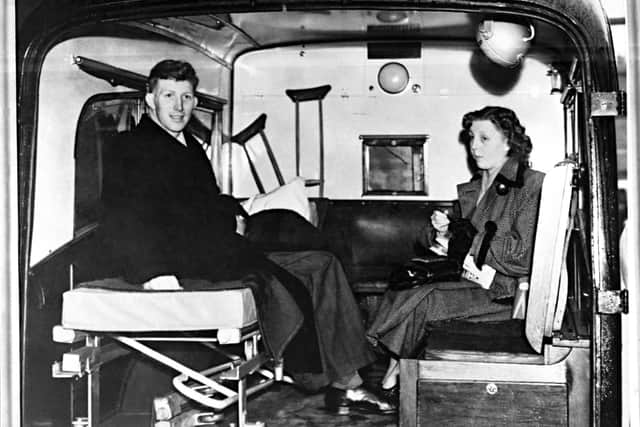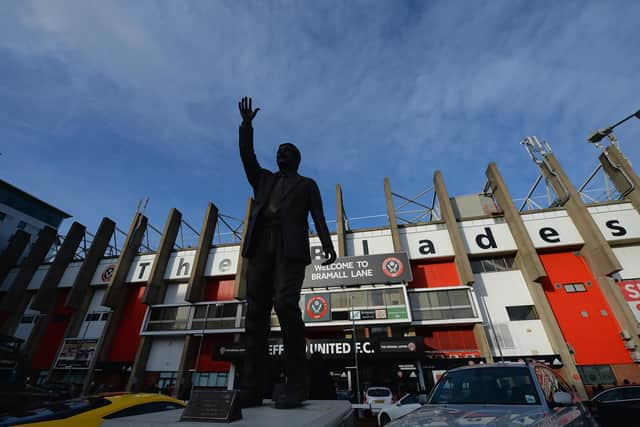On this day in 1953: Derek Dooley leaves hospital to start a lasting football legacy on both sides of the Steel City divide
and live on Freeview channel 276
And he did. On this day in 1953 Dooley left hospital with his wife after an operation removed the gangrenous lower half of his right leg, originally broken in two places in a collision with Preston North End keeper George Thompson on Valentine’s Day Day a few weeks earlier.
It is understood chemicals from the white line-markings at Deepdale had infected the injury through a cut at the back of his calf.
Advertisement
Hide AdAdvertisement
Hide AdA tragedy though it undoubtedly was, ending an increasingly promising career as one of the country’s most highly-rated forwards, it was an event that prompted a legacy on both sides of the Steel City’s footballing divide that went far, far beyond booting a ball into the back of a net.
He’s something of a forgotten man in national football terms, having never represented England despite a handsome goalscoring record for Wednesday returning 62 goals in 61 matches. But at both Hillsborough and Bramall Lane, Dooley is immortal.
In his final weeks on the pitch, he scored 16 goals between September and February and that rumours of a likely call-up in the weeks leading into his career-ending injury were getting louder makes the story all the more tragic.
Dooley of course also holds the unlikely-to-be-beaten Owls record of 46 goals in a single season back in 1950/52 as the club bounced back into the First Division as Champions at the first time of asking. Wednesday have a high bar, but Dooley sits among the most legendary playing figures the club has ever had.
Advertisement
Hide AdAdvertisement
Hide AdBadly handicapped with no education or trade, Dooley refused to step into the downward spiral of self-pity and set about rebuilding a new life. From his benefit match, he bought a house in Sheffield and made public his desire to continue working for the club he loved in the city he loved.


He went on to scout for the Owls at weekends and spent two years as a reporter for the Daily Mirror. A period working in a bakery for a company owned by a Wednesday director came before he worked back at the club, first in the commercial office flogging lottery tickets and then as manager as cash-strapped Wednesday sought to promote from within.
He took charge of the club for nearly three years before the infamous ‘mystery virus’ set in and set off a dour set of results. He was sacked in December 1973.
Years later he became commercial manager at Sheffield United of all clubs and went on to take the role of managing director. At the Hillsborough derby of 1992 he was paraded on the pitch and received a standing ovation from both sets of fans.
Advertisement
Hide AdAdvertisement
Hide AdIn 1999 Dooley became chairman of the debt-riddled, second-tier-languishing Blades and oversaw an incredible turnaround in fortunes that lead to a return to the Premier League in 2006.


He was made a freeman of the City of Sheffield in 1993 and a decade later was awarded an MBE in the New Years Honours List. Sheffield Hallam University bestowed him an honourary doctorate the same year. In 2007 he was named as one of the ‘Sheffield legends’ and was honoured with a plaque outside City Hall.
“I thought all those had gone by,” he said at the time, “but once again something else has cropped up, it's brilliant.
“That's what I like about Sheffield, I've had actual support from the public for a number of years. I've got involved in lots of things in Sheffield and I always had a fear that job-wise I would have to go out of the city, but that never happened and it never will now.
Advertisement
Hide AdAdvertisement
Hide Ad“You're either a blue and white or a red and white in this city, but I've been fortunate enough to have Wednesdayites and Unitedites always be good to me.”
Asked what makes Sheffield s great, he said simply: “I think mainly, the people of Sheffield.
“Wherever I've gone they've always looked after me and welcomed me. I've put a lot of effort into being involved, but I've enjoyed doing that, and have enjoyed meeting the people of Sheffield and doing certain things.”
Derek Dooley died in 2008 at the age of 78. He was mourned by both sets of Sheffield’s blue and red divide and a funeral at Sheffield Cathedral was attended by Sir Bobby Charlton and former Blades managers Neil Warnock and Dave Bassett, both of whom read eulogies.
Advertisement
Hide AdAdvertisement
Hide AdWarnock told BBC Radio Sheffield: “There will never be anyone like him again, he was loved by both sides of the city of Sheffield. He was just the greatest man in football that I've ever met and had the privilege to meet and a great loss."
His statue stands at Bramall Lane. United’s youth academy is named after him. Hillsborough’s executive suite bears his name and Sheffield Council named a section of the city’s ring road ‘Derek Dooley Way’. The legend lives on.